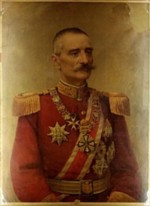Dubrovnik
To get into Old Dubrovnik one negotiates the steep winding streets of the extended city to the city gate.
As it's pedestrians only, one parks outside, in the pay by the minute car-park, and then wheels one's bags (two large and two small) over the road; across the drawbridge; and down the ramp to the gate, along with about five thousand other tourists.
OK I exaggerate. But there were a lot. Then (in our case) one drags one's bags along the main street to an ally and starts to climb: a long flight of relatively gently rising steps; until one reaches the first terrace; a gloriously level path, past the tables and chairs of several restaurants, to our street.
Here we are at the corner - lower right. Now the real athletic challenge begins - our apartment is halfway to the top
Although small, our accommodation was very central with a little kitchenette and there was a small supermarket a hundred meters down the hill, enabling us to have several meals for less than the price of one at restaurant with the smiling waitress above. But then, one does need to eat out at lunchtime and a restaurant is nice at night, so we made a more substantial contribution to the local economy than we might have done.
But our car was a problem. The car park adjacent to the gate charged 20 Euros an hour. Our host, an informative woman who spoke several languages and had experienced the shelling, had the solution. We drove to a distant parking place, near the hospital, and got a local bus back, providing an opportunity to stop at a shopping mall for wine and to have an inexpensive scenic tour of the prosperous suburbs.
The pristine streets and buildings of Dubrovnik show the benefit of its complete refurbishment after being shelled in 1991. As in Budva, Wendy had been here before the reconstruction and, as in Budva, much of her past experience was erased in the process.
Today Dubrovnik vies with Florence, in Italy, both in beauty and in the crush of tourists. While Florence has the Renaissance and the Medici and consequently much bigger churches, Dubrovnik's location and the harbour knock the River Arno into a cocked hat.
Dubrovnik vies with Florence both in beauty and in the crush of tourists
There are lots of shades of religion: Orthodox; Roman; Jesuit; Muslim; Pub
There were several more Christian churches
The mosque was well hidden and I never found the Synagogue
Christianity has various shades here: Eastern, Roman and early Jesuit. But in the shops and cafes Mammon appears to be the principal deity.
Dubrovnik provides plenty of opportunities to spend money
One way to part with some money is to walk around the walls. Wendy was resistant to this as the last time she was here it was public space and free. But there are alternatives. Nearby there is a fortified promontory that overlooks the city. There is also a mountain lookout restaurant reached by a cable car but that is anything but free.
But it's possible to do a bit of climbing instead
The harbour here has been fortified since around the 8th century CE. There was an ancient Greek city nearby but the Dubrovnik is Byzantine in its origins. The harbour is too small for modern shipping and cruise ships moor out in the deeper water and use their tenders to shuttle tourists back and forth. The lack of large ships allows for other uses including: kayaking, snorkelling and water polo.
Teams were playing water polo - others just having a swim
meanwhile, tourists came and went to the cruise ship off the point
One evening at twilight we sat out on the end of the bar at Dubrovnik with a nice rosé and enjoyed the moment.
It brought to mind the lines from Omar Khayyám:
A Jug of Wine, a Loaf of Bread - and Thou
Beside me singing in the Wilderness -
O, Wilderness were Paradise enow!
You can hear/read the entire poem here:
|
|
|
Rubáiyát of Omar Khayyám is the title that Edward FitzGerald gave to his 1859 translation from Persian to English of a selection of quatrains (rubāʿiyāt) attributed to Omar Khayyam (1048–1131), dubbed "the Astronomer-Poet of Persia". According to Wikipedia: "FitzGerald emphasized the religious scepticism he found in Omar Khayyam. In his preface to the Rubáiyát, he describes Omar's philosophy as Epicurean..." If you watch to the end I congratulate you. In sentiment, concerning the 'works of man', the Rubáiyát reminds me of Shelley's much more succinct: Ozymandias The sentiment is echoed by Shelly's friend, Byron, in his epic poem: Don Juan (even longer than the Rubáiyát - but more fun) Canto 1, Stanzas 218-219 218
What is the end of Fame? 'tis but to fill
A certain portion of uncertain paper:
Some liken it to climbing up a hill,
Whose summit, like all hills', is lost in vapour;
For this men write, speak, preach, and heroes kill,
And bards burn what they call their 'midnight taper,'
To have, when the original is dust,
A name, a wretched picture, and worse bust.
219
What are the hopes of man? old Egypt's King
Cheops erected the first pyramid
And largest, thinking it was just the thing
To keep his memory whole, and mummy hid;
But somebody or other rummaging,
Burglariously broke his coffin's lid:
Let not a monument give you or me hopes,
Since not a pinch of dust remains of Cheops.
|

